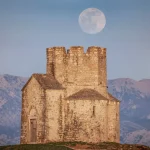Zeta is a river of unique biodiversity, history and heritage
Montenegro is a country of exceptional natural beauty, and its rivers play a key role in shaping the landscape and culture. Tara, with its deep canyon, attracts adventurers from all over the world, while Morača passes through the heart of Podgorica, giving the city a special charm. Ljuta, although short, impresses with its strength and fast flow. Among these water gems, the Zeta river occupies a special place, combining natural beauty with rich history and biodiversity.
The Zeta river springs from the Surdub stream in Nikšić plain, passes through an underground stream, and emerges again at the surface near Planinica. After that, it flows through the Bjelopavlić plain, meanders through fertile fields, and finally flows into the Morača not far from Podgorica. The total length of the river is 85 kilometers, and the basin covers an area of 1597 km². The river’s depth varies depending on the part of the stream and seasonal changes.
Historically speaking, the valley of the Zeta river was the cradle of many civilizations. On its banks are the remains of the ancient city of Duklja, which bears witness to the rich past of this area. Also, numerous bridges were built along the river, some of which date from the Ottoman period, representing significant cultural and historical monuments.

Emperor’s Bridge, Photo: Adria.fun
The flora and fauna of the Zeta river are extremely diverse. 774 plant species have been recorded in the area of the river, five of which are on the CITES list and the list of the Bern Convention. Among them are significant honey plants, medicinal plants and endemic species. Forests along the banks of the river are home to rare species such as the Skadar oak, while meadows and pastures provide habitat for many other plant species.
The fauna is equally impressive; 19 species of fish live in the river, including the endemic soft-lipped trout and bream. Also, 21 species of molluscs were recorded, among which three species of snails are protected at the national level, and an internationally protected species of freshwater crayfish. The diversity of habitats also supports a wealth of insects such as butterflies, dragonflies and dragonflies, many of which are important for protection under international and national legislation.

Zeta, Photo: Adria.fun
The Zeta river offers numerous opportunities for recreation and tourism. Its calm waters are suitable for fishing, and the surrounding nature for hiking and bird watching. Also, cultural and historical monuments along its course attract history and archeology lovers. In order to preserve its natural and cultural heritage, the Zeta river area was declared a Nature Park in 2019, to protect and sustainably develop this precious ecosystem.
If you get the chance, explore it up and down!
Five things you must not miss if you plan to visit Podgorica!




Leave a Reply